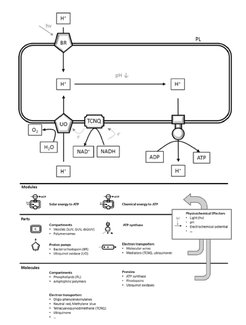Energy
Work Package L1
If chemical energy is used for ATP regeneration, nicotinamide adenine nucleotide (NAD) co-factor regeneration has to be considered as well. Apart from its role in an ATP regeneration, NAD regeneration is closely related to the bottom-up reconstitution of a variety of metabolic conversions and has an immediate impact on potential biotechnological applications (for example as in Work Package L2). Similar to ATP, NAD co-factor regeneration requires chemical or light energy inputs.
One of critical steps in sustaining of life-mimicking processes in synthetic cells is energy i.e. adenosine triphosphate (ATP) regeneration. Examples of such energy demanding processes in MaxSynBio consortium are metabolism (Work Package L2), cell division (Work Package L4) and motility (Work Package L5). Previous studies have shown that simple ATP addition or ATP regeneration systems which do not regenerate ATP directly from ADP and Pi have no or only limited successes due to accumulation of ATP hydrolysis products. Therefore, we aim to develop energy supply modules which can convert chemical or light energy into ATP. These modules are termed “Solar-to-ATP” and “Chemical-to-ATP” depending on the source of energy (light and chemical energy respectively) (Figure). In course of chemical/light energy conversions redox equivalents NADH/NAD+ might be formed. They are involved in many metabolic transformations in living cells and play also a role in metabolic transformations in the Work Package L2.

The modules envisaged in the Figure can be understood as combinations of functional parts, where a functional part consists of a membrane protein, or a chemical catalyst embedded into a suitable container (a vesicle or a hybrid vesicle or a polymersome). In the first funding period (2014-2016) the Work Package L1 focused on development of functional parts. In the second funding period the main focus will be on formation of functional modules out of functional parts. Additionally, the library of the functional parts will be further extended. Examples of new functional parts are light driven proton pump based on bacteriorhodopsin and NADH regeneration functional part. The latter one is necessitated due to introduction of a synthetic version of the Calvin cycle in the Work Package L2, which requires the reduced form of NAD. Further important issue will be long term stability of functional modules. This is especially important with respect to possible biotechnological applications of synthetic cells. Finally, we aim to integrate energy modules with energy demanding modules in Work Packages L2, Work Package L4 and Work Package L5 on a way to create a MaxSynBio synthetic cell.
